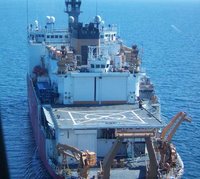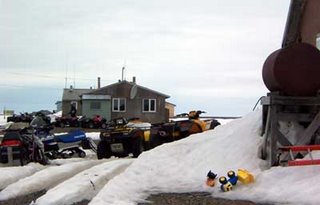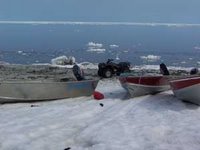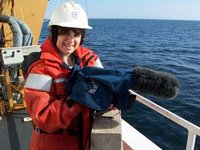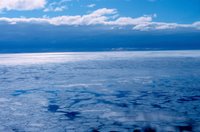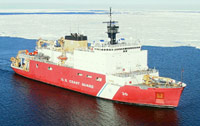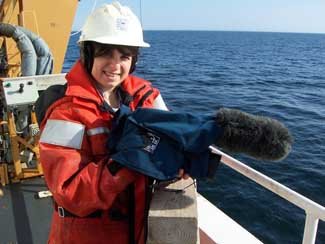Q & A: Jackie Grebmeier

Dr. Jackie Grebmeier, Department of Ecology and Evolutionary Biology, University of Tennessee, with sediment cores. (Photo: Peter West, NSF)
KdS: What is your main area of research?
JG: My interest has always been in invertebrate zoology. I like the animals in the mud. But I like ecosystem studies, so I’m interested in what happens in the water column, namely how it is important to animals in the sediments and how carbon is cycled back into the water column.
KdS: So what brings you all the way to the Bering Sea?
JG: Well my interest here is to look at what is happening to the ecosystem. I started studying here because it is an area where local subsistence is very important to human communities on the islands. But on this trip, I’m looking at the temperature and salinity of the water and how it influences the animals on the bottom.
KdS: Why is the Bering Sea such an important feeding ground?
JG: The Bering Sea is a very wide shelf that’s only 30 to 40 meters deep. It’s one of the most productive regions in the Arctic. Since it’s shallow, things produced in the upper water column, like plant material, can get down to the sediment. That’s what I’m the most interested in.
KdS: Why is the mud on the seafloor so important?
JG: So, if you’re a plant and you need to grow, you have to have sunlight and so you stay near the surface. So the animals at the bottom are food limited and the only food that they’re getting, their carbon, is coming down from the top. So plants get down to the bottom and these animals, like marine worms or clams, suck up the carbon that settles to the bottom. Clams, for instance, have little siphons, and like a vacuum cleaner they suck up that carbon.
KdS: Where does all of this carbon come from?
JG: Carbon is food. We’re carbon based animals. When I talk about carbon, it’s organic carbon. So instead of saying the lettuce or the carrots are getting down to the bottom, it’s the phytoplankton, you know, the diatoms. If you look at them under the microscope, they are the beautiful circles. Diatoms are made out of silica, but inside is lots of chlorophyll (the chemical that lets plants convert sunlight into energy).
KdS: So the bottom-dwellers live on the carbon that settles on the seafloor. Who eats the bottom-dwellers?
JG: Well, diving birds called eiders dive down about 30 meters for shelled animals called bivalves. Gray whales breed and have their babies in Baja, California, and they travel 4,000 kilometers to feed here in the Bering Sea because the food is so rich. It’s richer than anything you’re going to find off the California coast for maintaining a large population. That’s why people like to eat walrus and bearded seal; they grow fat feeding here.
KdS: What about the people who don’t eat walrus and seal?
JG: Everybody knows the Bering Sea, whether they know the name or not, if they eat at McDonalds or eat fish sticks or fake crab meat that’s really pollack. The fish that we eat on a normal basis comes from the Bering Sea. So our large fisheries in the US come out of the southern Bering Sea, and that’s because it is so productive.
KdS: What sorts of ecosystem changes are you monitoring?
JG: We’ve been working over 22 years in the area. Basically there’s been about a 50 percent decrease in the amount of carbon being produced. We have seen a decline particularly in the last seven or eight years .There are fewer animals, they weigh less and the ice is extremely variable. We’ve been seeing that the ice is leaving about three weeks earlier than before, and that has an impact because animals here are adapted to a timing of when they are available to use the organic matter. For example, zooplankton have a resting stage. They only come out at certain times when the water gets a certain temperature. They need time to kick in and start chomping down on the carbon. That doesn’t happen when you suddenly change the system.
The last five years have seen the largest ice retreat, and 2005 was the highest on record. It was probably in the mid-90s that we started to see this warming trend. As the water warms up, it can push what’s called the sub-Arctic to Arctic boundary north. And so what that does is push these bottom communities that are the base for walrus and gray whales and bearded seals. So for example, when I was back here in the 80s doing my PhD work, the gray whales were feeding all around the basin we were just studying last week between St. Lawrence Island and Little Diomede in the Bering Strait. They are now moving north to Barrow, Alaska to find other feeding grounds because the ones down here are becoming less productive.
KdS: What are you looking for when you collect samples at each station?
JG: I need to know temperature and salinity, and I need to know how much organic matter is present in the water to get an idea if a lot of it is getting down to the bottom. So we look at chlorophyll for that, and I need to know what water mass the animals live in. So I’m interested in where that food is being produced, where it’s going and how it influences the communities on the bottom.
KdS: How do you study the sediment?
JG: For the benthic stuff, I use a van Veen grab (see May 25th "Sea of the Midnight Sun" post for details) to figure out what’s down there, and I sift out anything bigger than one millimeter. I collect those animals that are left, and I preserve them for study over the winter time at the university. So we determine who is in the neighborhood, what their names are, which species interact with each other and what they weigh.
But I’m also interested in how much carbon gets to the sediment. So I run experiments on chambers of undisturbed cores of sediment. We have a cold temperature room on board, which is minus 1.6 degrees C, something like 27 or 28 F, which is the temperature at the seafloor. That doesn’t freeze like an ice cube in your freezer because it’s got salt in it. So the more salt it has, the more you can drive the temperature down.
You just leave your experiments closed in the dark and basically you’ve got a little aquarium. So you let it do its thing in the dark, because it’s dark down on the bottom. After about 12 to 14 hours, you would see a decline over time of oxygen. So as the animals and the bacteria in the sediment consume oxygen, they give off carbon dioxide. So it’s that oxygen/CO2 cycling that is so important to the system up here. But instead of doing something on the bottom of the ocean, I’m bringing cores up on the ship.
KdS: Why should we care about this region?
JG: Well, I think we should care because the Arctic is the first indicator of a warming trend. When the ice melts here, it’s not raising sea level, but our glaciers are melting in Alaska and Patagonia and especially in Greenland. I think the big thing is that we’re interconnected. Whether you live in California or Gambell, AK, we are not alone anymore. What we do will impact citizens in all other parts of the world. That’s why other countries are interested in studying the Arctic. What happens with weather in the Arctic influences China and crop production in other places of the world.

